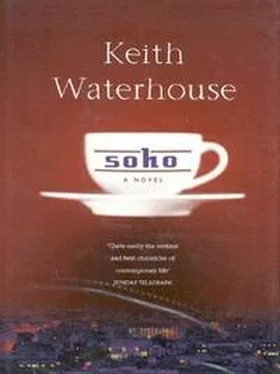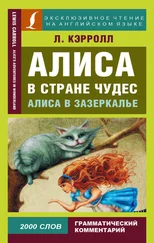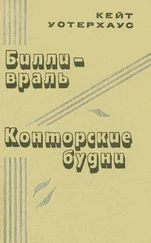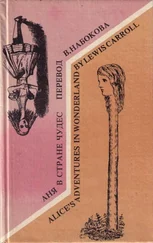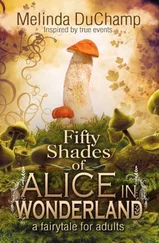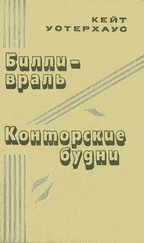There were many other things Old Jakie could remember, including how long since he had been barred from the Coach and Horses for doing so at length. These days he reminisces only briefly, and by request. This is seldom forthcoming, for considering its colourful past Soho is surprisingly unnostalgic — it has always lived for the day.
Black and white Soho comes next in the album — its best days, according to some. The war years and beyond, when the whole neighbourhood was seen through a pall of cigarette smoke (it has since become a “City of Westminster Air Quality Improvement Area”), and the girls, or Fifis as they were known, were as thick on the pavements as the pigeons in Trafalgar Square. All street life was there. Archer Street seethed with out-of-work musicians hanging around outside their union offices, hoping for session jobs. The shop doorways, where they didn’t harbour hookers, accommodated chefs and their commis coming up for a breath of coffee-scented air. Skulking dirty macs in search of what Soho calls “the Vice” contrasted with expensive camelhair overcoats draped across Italian shoulders. Clusters of drinkers, like witnesses to an accident, would congregate outside the French House — still, then, called the York Minster — and the Coach and Horses. Everyone wore a hat, and everyone was smoking.
Somewhere in that black and white montage you should find Else — Else for Elsie? Else for Elspeth? No one has ever known her first name, let alone her second — probably lighting one of her customary panatellas from the gasolier on the mahogany counter of the old cigar store on Old Compton Street. It’s a boutique now. As is Old Jakie’s Welsh Dairy, which first became a sex shop.
Soho wasn’t Soho without Else. And, even more alarmingly, still isn’t. She is one of the fixtures, a kind of human bollard.
She was a pretty young thing in those black and white days, Else. She always claims to have modelled for Francis Bacon and maybe she did, though nobody has ever seen the end result — it would probably look nothing like her, by the time he’d finished — which she says is owned by a rich New York collector. Augustus John she sat for: that’s well known. There are sketches and photographs of Else by lesser lights, when she was young and beautiful. Trouble is, she’s barred from most of the places that have them on their walls.
Even back in that black and white era, you couldn’t take Else anywhere. But then you didn’t have to — she was everywhere. If you went into the Coach, she was in the Coach. If you left the Coach and went into the French, she was in the French. These days, of course, you won’t find her in either place, or in any other pub that has seen her coming. That’s because over the years Else has got into the unfortunate habit of incontinence. So if she has managed to get into one or other pub while the guvnor’s back was turned, you can always tell she’s been by the faint whiff of panatella smoke, the faint whiff of Else, and the little damp patch on the bar stool where a cat with kidney trouble might have been dozing.
But that’s now, with Soho in living colour, when the likes of Else are not wanted. Then was then. In the black and white days Else was the life and soul of the party. A fixture in Aux Caves de France, but if you got fed up of buying her drinks — she was rarely in a position to buy drinks herself: no money, honey — and took yourself off to the Colony Room Club two doors away, she would have got there before you. The Colony Room, still known as Muriel’s although it’s years now since Muriel went under the sod. The Gargoyle. The Kismet, a.k.a. the Iron Lung. Why did they have all those clubs — over four hundred of them in and around the district at the height — when Soho itself was one big club?
We move on. The old Iron Lung is now a pizza parlour. The butcher’s in Brewer Street has become a champagne and oyster bar. Ten years ago it would have become a sex shop. Nowadays in Soho it is easier to buy a Filofax than a filthy mag, and easier to get a vodka martini than have your clock repaired, and the girls sipping their house bubbly in Kettner’s Champagne Bar who call themselves models, really are models this time round, limbering up for the Soho Fashion Fair at the Café Royal. We are in colour.
Most of Old Jakie’s distantly remembered Bohemians are long gone, dead of cirrhosis of the liver or retired to the country or gone legit with Arts Council grants and BBC contracts. Ellis Hugo Bell, thinking Courtney Love, thinking Minnie Driver, is, along with his Wardour Street friends and enemies, a more typical Soho habitué these days; and the state-of-the-art chrome and glass restaurants and open-fronted cafés, with their tiled floors and bentwood tables, more typical than the nicotine-drenched wining and dining garrets of Soho’s black and white and sepia periods.
As Old Jakie tells it, a local authority which once actively encouraged the bulldozing of Soho, to replace it with thirty-storey bleeding tower blocks, a six-lane bleeding highway and elevated bleeding concrete walkways from Oxford Street to Shaftesbury Avenue, finally decided that if it couldn’t beat them it would join them, and after initially resisting the spread of pavement cafés on the grounds that they would impede any two handicapped people trying to pass one another in wheelchairs (only Jeffrey Bernard was passing by in a wheelchair, and he didn’t mind), it eagerly did its best, as is the way of city councils after the reprieve of a disastrous planning decision, to back-pedal by gentrifying the area to within an inch of its life, with hanging flower baskets, cobbled pedestrian areas, and a sanitised street market. Len Gates approves: he calls it regeneration. Old Jakie has another view: “If they can’t fuck it up in one way, they’ll fuck it up in another.”
But you can’t keep old Soho down. Behind the designer glitz and the chrome and the black leather armchairs there still survives more than a goodly handful of sex shops and strip shows — ask Stephan Dance, although he’ll say the game is finished; and models of the old sort still occupy second-floor walk-ups in the newly cobbled alleys, although more discreetly nowadays, behind their lit-up doorbells. And there are still a few of the old Soho drinking clubs. The Colony Room is still there. Gerry’s Club is there, and thriving. So is Kemble’s, the rival actors’ club, and struggling. The old Kismet Club in Great Newport Street is, as we know, no more, but the new Kismet Club at the end of Frith Place, no relation, staggers on.
According to Mabel, who owns the place, there won’t be any drinking clubs like the New Kismet still going a year or two from now, not the way the licensing laws are being liberalised. There aren’t all that many of them left now — a dozen, perhaps, if you’re talking about ordinary drinking clubs, places you’d once go to when the pubs had to close in the afternoons, as against gambling clubs, most of them in Chinatown, or clubs for specialised trades such as waiters or chefs or criminals.
Golden days, Mabel calls that wonderfully repressive era when you couldn’t get a drink legally for fourteen and a half hours out of the twenty-four. Her membership register was like a starstruck fan’s autograph book — Charlie Chaplin, Bing Crosby, Humphrey Bogart, Laurence Olivier. And then there were even those who came off the street and signed themselves in under their own names, for some strange reason. Genuine addresses too, in some cases. You’d think they wanted to be arrested.
Mabel had opened the New Kismet when the old Kismet in Great Newport Street had closed, and she had never looked back until just lately. Afternoons only the New Kismet was these days, three till seven, that was enough for Mabel at her age, then they could bugger off back to the French or the Coach or wherever they wanted. It is getting so it is all the same to Mabel whether they come down or not. Time to be putting her feet up. Little place in Brighton. Soho by the Sea.
Читать дальше
